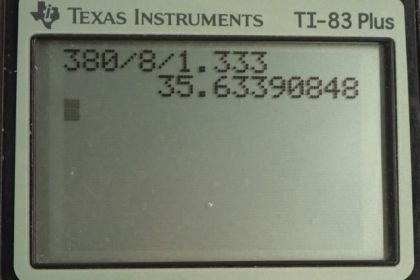- The soap bubble will pop with the slightest breeze.
Solution video
OpenStax College Physics, Chapter 27, Problem 77 (Problems & Exercises)

Calculator Screenshots
Comments
Hello,
In this problem, wouldn't the path length difference just be 2t? I was under the impression that the difference in path length was just equal to twice the thickness of the thin film, and didn't depend on the index of refraction, n.
Thanks!
For your reference, I have copy/pasted a definition for path length difference as it relates to thin film interference that I found online: "For waves incident normal to the film, the path length difference is twice the film thickness (∆ℓ = 2t)" Is this the correct definition for path length difference? Based on how it sounds here, I wouldn't think to take the index of refraction into account for this value.
Hi ts,
This is an important question. What you're describing is the path length difference if you measured with a ruler. However, it isn't strictly the path difference that we're interested in. What we're interested in is the phase difference between the two waves. The difference in path length traveled causes a phase difference, sure, but it's the phase difference that we need to calculate. What's interesting is to know how much the wave that traveled through the thin film progressed during its journey down, then back up, through the thin film. The amount it progresses depends on its wavelength in the thin film. Consider a thought experiment: imagine that upon entering the thin film, the wave was stretched so that its wavelength became the same as the thickness. In this scenario, when that wave emerges from the top of the thin film to combine (interfere) with the wave that reflected directly from the top of the film, there would be constructive interference since the wave traveling through the thin film progressed exactly two wavelengths (once down, then again back up), so it would be in phase with the top-reflected wave. Crests would overlap and a drawing of the two waves would look exactly the same. In this thought experiment, I'm trying to illustrate that it doesn't matter what the thin film thickness is. The number of wavelengths progressed is what matters. The number of wavelengths progressed will be the wavelength in the film divided by the film thickness, and the wavelength in the film is .
Hope this helps,
Shaun
Hi
So based on your clarification above, shouldn't Φ be path length difference as stated on the video ? rather should Φ be the path length difference ?
Thank you
Eray
For the correction rather "should Φ be the phase difference ?"
Hi Eraycey, thank you for the question. I think the best terminology to use is whatever leads to a good understanding, and good problem solving. You're quite right that phase difference is what's important, but the phase shift of the ray that penetrates the thin film is due entirely to a path length difference compared with the ray reflected from the top of the film. The penetrating ray doesn't experience any phase shift due to reflection from the bottom interface between the thin film and air since at that interface its initial medium is of high index of refraction and the second medium is of low index of refraction. For the penetrating ray, phase shift and path length difference can be used interchangeably since in this particular circumstance the phase shift is due exclusively to the path length difference, so I don't think it's helpful (even though it isn't wrong) to say "phase shift" instead of "path length difference".
Hope this helps,
Shaun



